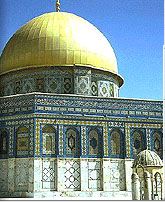|

Other Buildings on Temple Mount
|
Four prayer platforms and various bathing installations are mentioned in the sources as well. Unfortunately, it is impossible to identify these buildings today - their names might have changed over the years. Other structures, not mentioned by any of the early Arab geographers, are attributed by the late chroniclers to the early Arab rulers of Jerusalem: |
(1) Qubbat Suleiman/Qubbat Daud - in the northern part of the Temple Mount. It had an octagonal plan, crowned by a dome, with a mihrab in the south. The Guide to the Holy Places (1470) states that this structure belonged to Suleiman, the seventh caliph of the Umayyad dynasty (715-717). Mujir ad-Din, too, connects this building to the Umayyad caliphate. On the floor of the structure is a small rock, Qubbat as-Sakhra as-Saira, which is a fragment of the foundation stone.
(2) Kursi Suleiman (Solomons chair) - north of the Golden gate, adjacent to the eastern wall. Tradition says that this is where King Solomon prayed after he completed building the temple. It was a closed, rectangular building, roofed by a flat ceiling and two domes (probably of a later date). The building is mentioned by Kazawini (1283); according to Nasir-i-Khusarau this structure was located in the Golden gate.
(3) mihrab Daud - a niche in the southern wall, near the southeastern corner of the Temple Mount enclosure. This area suffered from earthquakes and is therefore referred to in descriptions of reconstruction works�one of them executed by the Fatimid caliph Tahir in 1034/5, following the earthquake of 1033. Nasir-i-Khusarau states that this structure was in the northern part of the Temple Mount. |

|


